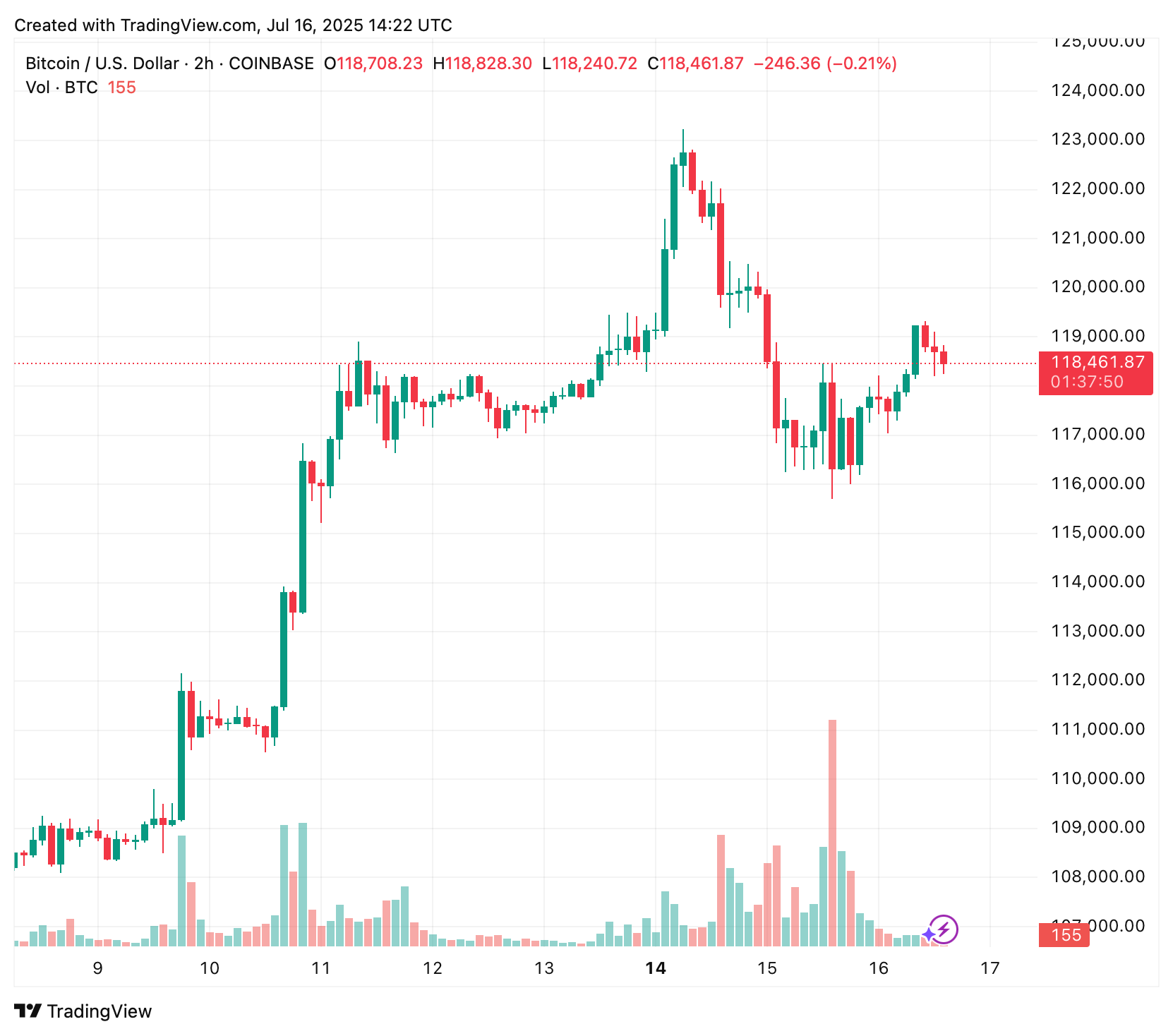Here’s How Bitcoin Reacted to the June PPI Report
16.07.2025 17:25 2 min. read Kosta Gushterov
Bitcoin showed a brief bullish reaction to the June U.S. Producer Price Index (PPI) release at 12:30 UTC, but the move quickly lost steam as traders digested the broader implications of the data.
At the moment of the PPI release on July 16, Bitcoin was trading near $117,600. Over the following two hours, the price jumped sharply to a high of $119,400, gaining over $1,800 in a swift move. However, the rally proved short-lived. Sellers stepped in above the $119K level, pushing BTC back toward $118,400 by 14:22 UTC, as seen in the 2-hour Coinbase chart.

The initial spike was likely driven by the market’s interpretation of the flat PPI reading. The headline PPI showed no month-over-month change in June, suggesting a potential cooldown in producer-side inflation pressures. This reinforced hopes that the Federal Reserve may have more flexibility to cut rates later in the year.
However, a deeper look into the report painted a more complex picture. While services prices declined by 0.1%, goods inflation remained firm, especially in energy and core goods categories. Annual PPI still rose 2.3%, and core PPI (excluding food, energy, and trade) held steady at 2.5%—indicating that inflation remains sticky on a yearly basis.
READ MORE:

How Can You Tell When it’s Altcoin Season?
As a result, Bitcoin’s brief rally met resistance, reflecting cautious investor sentiment. While the flat PPI print opened a window for optimism, it wasn’t enough to drive a sustained breakout above $120K. The market remains sensitive to any data that could sway Fed policy expectations, and with inflation signals still mixed, BTC traders appear unwilling to chase price aggressively.
For now, Bitcoin continues to hover around $118,400 as the broader macroeconomic picture remains uncertain.
-
1
Robert Kiyosaki Buys More Bitcoin, Says He’d Rather Be a ‘Sucker Than a Loser’
02.07.2025 22:00 1 min. read -
2
This Week in Crypto: Whale Accumulation, Ethereum Signals, and a Sentiment Shake-Up
05.07.2025 21:00 3 min. read -
3
BlackRock’s IBIT Bitcoin ETF Surpasses 700,000 BTC in Record Time
08.07.2025 19:00 2 min. read -
4
Veteran Trader Peter Brandt Shares Simple Wealth Strategy with Bitcoin at Its Core
30.06.2025 15:00 2 min. read -
5
Bitcoin Tops Crypto Social Buzz as $110,000 Milestone Fuels Market Debate
04.07.2025 8:15 3 min. read
Bitcoin ETFs Attract Over $2 billion in Weekly Inflows: What’s Driving the Gains?
Bitcoin ETFs in the U.S. recorded $2.39 billion in net inflows over the past week, according to data from Farside Investors, marking one of the strongest capital surges since their launch.
Weekly Crypto Roundup: Bitcoin Hits ATH, Ethereum Surges, Trump Advances Crypto Reforms
Analyzing the latest updates shared by Wu Blockchain, this past week underscored a pivotal shift in the crypto landscape. Bitcoin surged to a new all-time high of $123,226, pushing the overall crypto market cap beyond $4 trillion—a milestone reflecting renewed investor confidence and accelerating institutional flows.
Over $5.8 Billion in Ethereum and Bitcoin Options Expired Today: What to Expect?
According to data shared by Wu Blockchain, over $5.8 billion in crypto options expired today, with Ethereum leading the action.
IMF Disputes El Salvador’s Bitcoin Purchases, Cites Asset Consolidation
A new report from the International Monetary Fund (IMF) suggests that El Salvador’s recent Bitcoin accumulation may not stem from ongoing purchases, but rather from a reshuffling of assets across government-controlled wallets.
-
1
Robert Kiyosaki Buys More Bitcoin, Says He’d Rather Be a ‘Sucker Than a Loser’
02.07.2025 22:00 1 min. read -
2
This Week in Crypto: Whale Accumulation, Ethereum Signals, and a Sentiment Shake-Up
05.07.2025 21:00 3 min. read -
3
BlackRock’s IBIT Bitcoin ETF Surpasses 700,000 BTC in Record Time
08.07.2025 19:00 2 min. read -
4
Veteran Trader Peter Brandt Shares Simple Wealth Strategy with Bitcoin at Its Core
30.06.2025 15:00 2 min. read -
5
Bitcoin Tops Crypto Social Buzz as $110,000 Milestone Fuels Market Debate
04.07.2025 8:15 3 min. read

